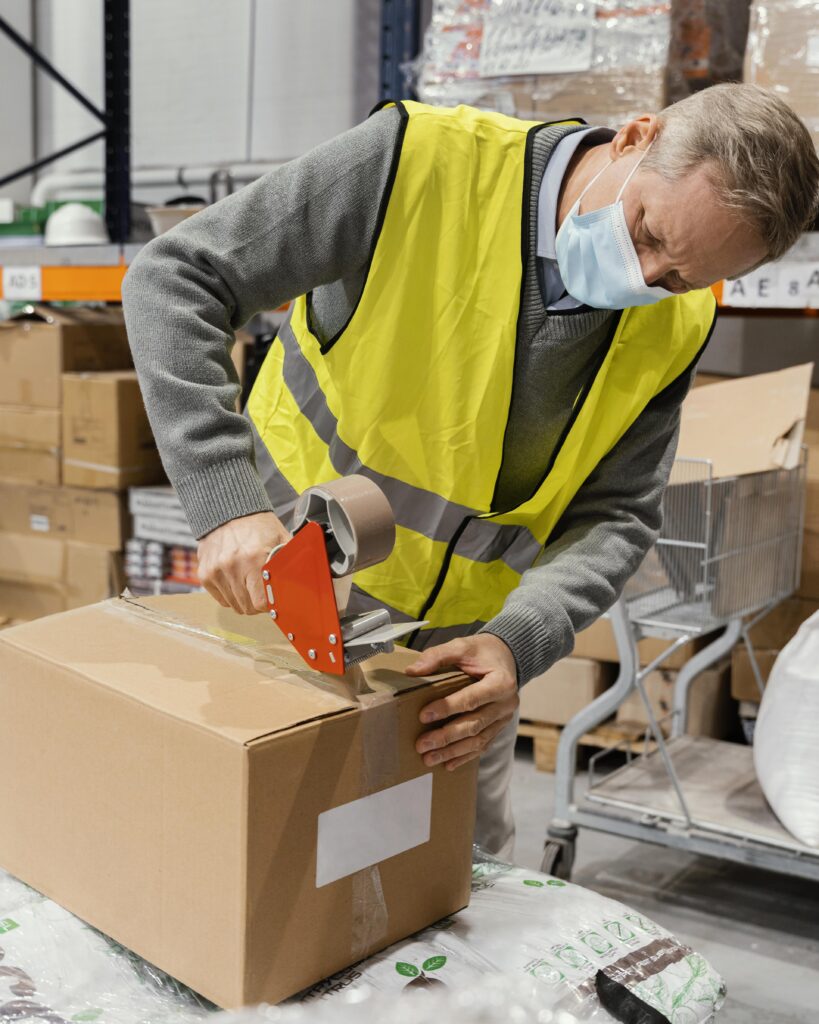Programs That Build Greener Operations in Packaging

Programs That Build Greener Operations in Packaging Greener packaging is no longer a choice—it’s a business necessity. To get to greener operations, packaging facilities require more than green materials and energy-saving equipment; they require employees skilled to execute and sustain sustainable processes. Effective training ensures that ESG goals are achieved while minimizing waste, enhancing quality, and maximizing production efficiency. At POSITIIVPLUS, we deliver ESG-centric training programs specific to packaging manufacturers, enabling teams to embrace greener operations effortlessly. In this blog, we delve into how training can promote sustainability within the packaging sector. Why Training is Imperative for Greener Packaging Operations Implementation of Sustainable Practices Trained employees in green processes are able to implement sustainable practices on a regular basis, minimizing material waste and energy use. Operational Efficiency Well-trained personnel can detect and mitigate process inefficiencies, reduce downtime, and ensure machine performance, promoting lean and green production. ESG Compliance Educated teams are more likely to meet environmental laws and internal ESG targets, promoting uniform compliance throughout the production line. Employee Engagement and Innovation Training initiatives promote employees to make suggestions for waste reduction, material optimization, and environmental performance improvement. Elements of Effective Packaging Sustainability Training Programs Process and Equipment Training Train personnel to work machinery effectively to reduce waste, energy consumption, and faults. Material Optimization Workshops Train employees in choosing sustainable materials, minimizing excessive use, and disposing of recyclable packaging in the right manner. Real-Time Monitoring and Analytics Training Equip personnel to utilize dashboards and digital platforms to monitor efficiency, identify faults, and react accordingly. ESG and Regulatory Awareness Make employees aware of environmental law, compliance regulations, and corporate sustainability goals. Continuous Learning and Feedback Recurrent refresher training, performance audit, and feedback mechanisms keep staff current with best practice and new trends. Conclusion: Training as the foundation for greener packaging Green operations within the packaging factory take more than policies—they take the right employees who can effectively execute sustainable behavior. Through investments in training programs that emphasize ESG, process optimization, and material effectiveness, manufacturers can attain greener operations and better productivity and compliance. At POSITIIVPLUS, we assist packaging makers to create and provide training programs that develop a workforce with the capability to drive sustainability and operational excellence. Create a talented, sustainability-oriented team. Find out more about our ESG-based training solutions for packaging plants at POSITIIVPLUS. Programs That Build Greener Operations in Packaging hardik • September 26, 2025 • Packaging • No Comments Sustainable Packaging Production Without Complexity The packaging market is coming under mounting pressure to provide sustainable solutions. Consumers, regulators, and brands are … Sustainable Packaging Production Without Complexity hardik • September 26, 2025 • Packaging • No Comments Sustainable Packaging Production Without Complexity The packaging market is coming under mounting pressure to provide sustainable solutions. Consumers, regulators, and brands are … Costs of Scrap and Idle Time in Plants hardik • September 26, 2025 • Packaging • No Comments Costs of Scrap and Idle Time in Plants In the packaging business, speed and accuracy are paramount. But two quiet profit-killers—scrap and … Time Data to Eliminate Packaging Line Defects hardik • September 26, 2025 • Packaging • No Comments Time Data to Eliminate Packaging Line Defects In packaging, efficiency and quality are paramount. One blemish on the pack line—misprints, sealing flaws, …
Sustainable Packaging Production Without Complexity

Sustainable Packaging Production Without Complexity The packaging market is coming under mounting pressure to provide sustainable solutions. Consumers, regulators, and brands are all looking for green packaging that reduces packaging waste, keeps carbon footprint low, and meets global ESG (Environmental, Social, and Governance) norms. But for most manufacturers, it seems daunting—complex procedures, increased costs, and lack of compliance certainty often deter companies. At POSITIIVPLUS, we figure that sustainable packaging doesn’t have to be difficult. Through real-time tracking, data analytics, and more efficient use of resources, producers are able to be more environmentally friendly, more efficient, and more profitable. This blog discusses how to make the path toward sustainable packaging production easier. Why Sustainable Packaging Matters Growing Consumer Demand Consumers prefer green packaging alternatives and are willing to pay more for products that show sustainability. Regulatory Compliance Governments across the globe are implementing tighter regulations on single-use plastics, recyclability, and carbon reporting. Brand Reputation Sustainability fosters trust and loyalty, particularly in sectors such as food, drinks, cosmetics, and online shopping. Cost Efficiency Over Time While there is a big upfront cost, sustainable operations eliminate material waste and energy expenses in the long term. The Hidden Barriers to Sustainable Packaging Perception of High Costs: Most plants believe environmentally friendly materials and processes always incur higher expense. Operational Complexity: A switch to biodegradable or recyclable materials tends to feel like a disruptive shift. Uncertainty Around ESG Compliance: Manufacturers worry about failing short of expectations in the absence of direct measurement instruments. Making Sustainable Packaging Simple Real-Time Data Monitoring Monitor resource consumption, scrap rates, and machine performance in real time to minimize waste and energy usage. Material Optimization Apply analytics to choose packaging materials that weigh sustainability against durability and affordability. Smart Supplier Audits Assess supplier practices to satisfy sustainability standards and provide compliant raw materials. Staff Training Provide employees with intelligence to manage new materials and green processes without disruption. Predictive Analytics Avoid downtime and overproduction that result in wasted materials and energy. Conclusion: A Smarter Road to Sustainable Packaging Sustainable packaging doesn’t have to be complicated or expensive. With the perfect balance of real-time information, predictive insights, and efficient processes, packaging converters can adopt cleaner production with assurance. The payoff? Reduced waste, lower costs, enhanced compliance, and heightened customer confidence. At POSITIIVPLUS, we make sustainable packaging easy with solutions that enable plants to produce smarter, leaner, and greener. Simplify your way to sustainability. Find our ESG-driven solutions for packaging factories at POSITIIVPLUS. Sustainable Packaging Production Without Complexity hardik • September 26, 2025 • Packaging • No Comments Costs of Scrap and Idle Time in Plants In the packaging business, speed and accuracy are paramount. But two quiet profit-killers—scrap and … Costs of Scrap and Idle Time in Plants hardik • September 26, 2025 • Packaging • No Comments Costs of Scrap and Idle Time in Plants In the packaging business, speed and accuracy are paramount. But two quiet profit-killers—scrap and … Time Data to Eliminate Packaging Line Defects hardik • September 26, 2025 • Packaging • No Comments Time Data to Eliminate Packaging Line Defects In packaging, efficiency and quality are paramount. One blemish on the pack line—misprints, sealing flaws, … Building a Skilled Workforce for Greener Mills hardik • September 26, 2025 • Textile • No Comments Building a Skilled Workforce for Greener Mills The textile industry’s future is sustainable production, and skilled labor is the core of that …
Costs of Scrap and Idle Time in Plants

Costs of Scrap and Idle Time in Plants In the packaging business, speed and accuracy are paramount. But two quiet profit-killers—scrap and downtime—tend to go unnoticed until they cause real financial and operational losses. From wasted packaging film and ink to dormant labeling machines, these wastes don’t merely damage the bottom line; they also harm sustainability initiatives and ESG (Environmental, Social, and Governance) compliance. At POSITIIVPLUS, we provide ESG-based, real-time monitoring solutions to assist packaging factories in minimizing scrap and idle time. In the following blog, we will deconstruct the hidden costs and how data-based strategies can avoid them. The Hidden Costs of Scrap in Packaging Plants Material Waste Misprints, improper label positioning, packaging film in excess, and sealing flaws all create pointless scrap that directly adds up to expenses. Ink, Adhesive, and Energy Losses Each faulty run not only consumes raw materials but also energy, ink, and adhesives that cannot be salvaged. Environmental and ESG Risks Unrecyclable plastic waste, labels, and chemical-laden scrap contribute to landfill and ecological pollution, weakening sustainability goals. Decreased Output Capacity Each hour used disposing of or respinning faulty packages takes away capacity for meeting customer orders. The Hidden Costs of Downtime Labor Inefficiencies When there is waiting by packaging operators for machine jams or slowdowns, paid labor hours are lost productivity. Equipment Underutilization Idle labeling, printing, or sealing equipment lowers ROI on equipment investments. Delayed Deliveries Production halt causes bottlenecks, resulting in lost deadlines and customer dissatisfaction. Lost Revenue Idle plants can’t accommodate demand surges, resulting in lost revenue opportunities and strained customer relationships. Methods for Reducing Scrap and Idle Time in Packaging Real-Time Monitoring Systems Monitor packaging line performance—catch misalignments, faulty seals, or misprints in real time to save scrap. Predictive Maintenance Leverage AI-based tools to predict equipment failures and avert expensive downtime. Streamlined Changeover Processes Optimize and standardize machine configurations to save idle time on product or packaging format changes. Operator Training Empower personnel with capability to identify and fix tiny problems before they become complete production shutdowns. ESG Alignment Scrap reduction, energy savings, and resource optimization help in meeting environmental targets as well as customer-led sustainability expectations. Conclusion: Turning Hidden Costs into Competitive Advantage Idle time and scrap are not only production snafus—they are quiet drains on profitability, productivity, and sustainability. With the use of real-time tracking, preventive maintenance, and ESG-based best practices, packaging facilities can significantly reduce waste, enhance productivity, and build a better reputation with environmentally responsible customers. We at POSITIIVPLUS assist packaging producers in avoiding unnecessary expenses and ensuring operational excellence while driving ESG initiatives. Ready to slash waste and downtime at your packaging facility? Discover our real-time ESG-driven solutions at POSITIIVPLUS. Costs of Scrap and Idle Time in Plants hardik • September 26, 2025 • Packaging • No Comments Time Data to Eliminate Packaging Line Defects In packaging, efficiency and quality are paramount. One blemish on the pack line—misprints, sealing flaws, … Time Data to Eliminate Packaging Line Defects hardik • September 26, 2025 • Packaging • No Comments Time Data to Eliminate Packaging Line Defects In packaging, efficiency and quality are paramount. One blemish on the pack line—misprints, sealing flaws, … Building a Skilled Workforce for Greener Mills hardik • September 26, 2025 • Textile • No Comments Building a Skilled Workforce for Greener Mills The textile industry’s future is sustainable production, and skilled labor is the core of that … Sustainable Textile Production Made Simple hardik • September 26, 2025 • Textile • No Comments Sustainable Textile Production Made Simple The fashion industry is in the midst of a dramatic shift as sustainability becomes top of mind. …
Time Data to Eliminate Packaging Line Defects

Time Data to Eliminate Packaging Line Defects In packaging, efficiency and quality are paramount. One blemish on the pack line—misprints, sealing flaws, or material irregularities—can result in expensive rework, product recall, and lost resources. With increasing ESG pressures and increasing consumer expectations, inefficiencies in packaging operations cannot be afforded by companies. Real-time data is revolutionizing the way packaging companies track, identify, and drive out defects. At POSITIIVPLUS, we offer ESG-led digital solutions that enable packaging businesses to optimize operations, minimize waste, and attain consistent quality. This blog discusses how real-time monitoring can eliminate packaging line defects and drive sustainability objectives. The Hidden Costs of Packaging Line Defects Wasted Materials and Energy Each faulty package represents wasted raw materials and extra energy spent in reprocessing. Production Schedule Delays Defects tend to create bottlenecks that disrupt timelines and escalate downtime costs. Brand Damaged Reputation Substandard packaging erodes consumer confidence, particularly in the food, beverage, and pharmaceutical industries. ESG and Compliance Hazards Defects can result in non-compliance with safety and sustainability regulations, elevating regulatory hazards. How Real-Time Data Enhances Packaging Quality Real-Time Defect Detection Sensors and AI cameras identify misprints, seal breakdowns, or wrong labeling in real-time, cutting off defective products from going downstream. Predictive Maintenance for Machines Equipment failures can be forecasted using real-time data, allowing maintenance before defects are formed. Standardized Quality Across Lines Several packaging lines across different plants may be tracked at the same time to achieve uniform standards. Optimized Resource Utilization Reducing rework and material losses, companies save money and minimize their ecological footprint. Automated Compliance Reporting Digital systems offer traceable records to aid audits, simplifying ESG and regulatory compliance. Conclusion: Defect-Free Packaging Through Data Defects on packaging lines are wasteful, expensive, and harmful to profitability and reputation. Real-time data provides an anticipatory solution, enabling manufacturers to detect problems immediately, minimize waste, and facilitate ESG compliance. At POSITIIVPLUS, we offer packaging businesses smart solutions to eradicate flaws, maximize operations, and provide environmentally friendly, quality packaging solutions. Eradiate flaws with live insights. Learn more about our ESG-influenced packaging solutions at POSITIIVPLUS. Time Data to Eliminate Packaging Line Defects hardik • September 26, 2025 • Packaging, Textile • No Comments Building a Skilled Workforce for Greener Mills The textile industry’s future is sustainable production, and skilled labor is the core of that … Building a Skilled Workforce for Greener Mills hardik • September 26, 2025 • Textile • No Comments Building a Skilled Workforce for Greener Mills The textile industry’s future is sustainable production, and skilled labor is the core of that … Sustainable Textile Production Made Simple hardik • September 26, 2025 • Textile • No Comments Sustainable Textile Production Made Simple The fashion industry is in the midst of a dramatic shift as sustainability becomes top of mind. … The Hidden Costs of Downtime in Textile Manufacturing hardik • September 26, 2025 • Textile • No Comments The Hidden Costs of Downtime in Textile Manufacturing In textile production, downtime is not only lost production time—it affects profitability, sustainability, and …